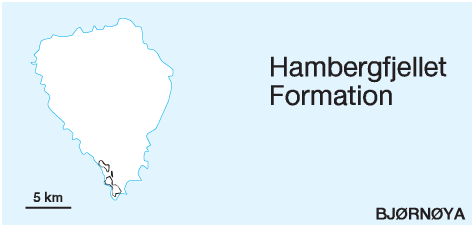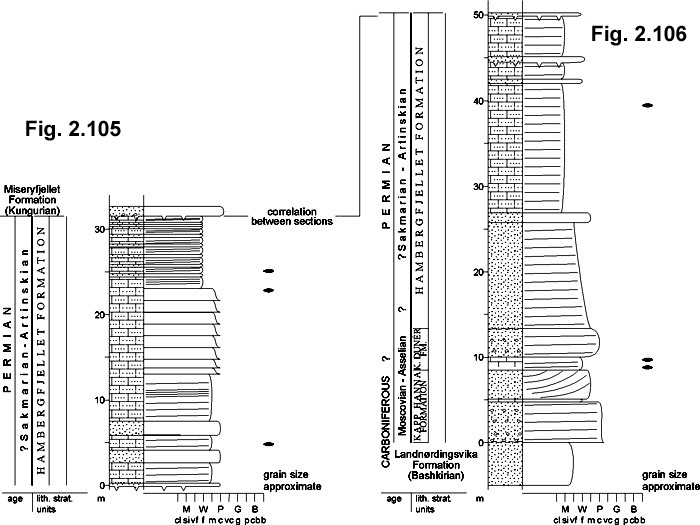 |
|
 |
|
|
from: Dallmann. W.K. (ed.). Svalbard lithostratigraphic lexicon
BJARMELAND GROUP (CP-76) STATUS OF UNIT: Formal FIRST USE OF NAME: Committee on Upper Palaeozoic Stratigraphy of the Barents Sea Shelf (in prep.) CURRENT DEFINITION: Here, following the proposal of the Committee on Upper Palaeozoic Stratigraphy of the Barents Sea Shelf. SYNONYM(S) AND REFERENCE(S): None ORIGIN OF NAME: Bjarmeland: An Old Norse name assigned to an area at the White Sea and the river Dvina (northwestern Russia). The group name is derived from the Bjarmeland Platform, a structural element on the southern Barents Sea Shelf. TYPE AREA: Bjarmeland Platform, southern Barents Sea Shelf STRUCTURAL SETTING: Late Palaeozoic platform of Svalbard/Barents Sea Shelf DEPOSITIONAL AGE: Sakmarian - Artinskian OVERLYING UNIT(S): Tempelfjorden Group UNDERLYING UNIT(S): Gipsdalen Group SUPERIOR UNIT: None OTHER USE OF NAME: Bjarmeland Platform (Gabrielsen et al. 1990): A syndepositional structural element on the southern Barents Sea Shelf, where the group is typically developed. THICKNESS: 233-488 m on the Bjarmeland Platform, 88-105 m on the southern Finnmark Platform, up to 70 m on Bjørnøya MAIN LITHOLOGIES: Limestone, chert, sandstone, siltstone DESCRIPTION: The Bjarmeland Group occurs on the southern Barents Sea Shelf, with a wedge extending onland on Bjørnøya. It is thickest throughout the Bjarmeland Platform including the eastern flank of the Loppa High and northern areas of the Finnmark Platform. The group onlaps palaeohighs within the platform and the margins of the depositional basin such as the eastern flank and crestal areas of the Loppa High and the southern parts of the Finnmark Platform. In these areas the uppermost part of the group was subaerially exposed and karstified before flooding in the late Permian. Bjørnøya – situated on the Stappen High which had a similar Permian uplift history – shows a similar overall development to that of the Loppa High. The lower parts of the group, developed in platform and basinal areas offshore, are probably not represented by the onshore exposures on Bjørnøya. Lithologies are dominated by white to light grey bioclastic limestones, although dark grey to black and argillaceous, locally bituminous limestones also occur. Minor amounts of cherts occur, especially in the uppermost part. Minor intercalations of silt- and sandstones are locally recognised. In the reference area on the Polheim Subplatform fine-grained siliciclastics and marls dominate the succession. Deposition took place in a marine environment during an overall rise in relative sea level, except for the lowermost parts of the group that were deposited during a relative low sea level. These "lowstand" sediments are confined to the distal and more rapidly subsiding parts of the Bjarmeland Platform and northern areas of the Finnmark Platform. During the Late Artinskian both basinal margins and structural highs were flooded. In shallow marine areas coolwater carbonate sedimentation took place giving rise to an abundant fauna of bryozoans, crinoids, echinoderms and brachiopods. The lower part of the Bjarmeland Group typically comprises large carbonate build-ups dominated by bryozoans and Tubiphytes. These represent major structures, up to 600 m or 700 m thick, which are easy to map on seismic profiles. Inter-reef facies are fine-grained carbonate rocks and shales, locally with mass transport sediments derived from the reeves. The bioclastic grain-/packstone to locally wackestone facies of the upper and geographically widespread formation of the Bjarmeland Group contains a fully marine fauna of crinoids, brachiopods, echinoderms, bryozoans and occasional locally sponges, suggesting that sedimentation most probably took place in an open high energy shelf environment. HAMBERGFJELLET FORMATION (CP-77)  DISTRIBUTION shown on Fig. 2-05
DISTRIBUTION shown on Fig. 2-05STATUS OF UNIT: Formal FIRST USE OF NAME: Worsley & Edwards 1976 CURRENT DEFINITION: Worsley & Edwards 1976 SYNONYM(S) AND REFERENCE(S): "Cora limestone": Andersson 1900; "Alfredfjellet Formation": Krasil'ščikov & Livšic 1974. Although Krasil'ščikov & Livšic (1974) publication with the name "Alfredfjellet Formation" was issued earlier, the manuscripts were written simultaneously and the original paper in Russian was not readily available to geologists outside the USSR. This is valid for several units on Bjørnøya. We recommend the use of Worsley & Edward's (1976) nomenclature, because this is better established in the published literature. ORIGIN OF NAME: Hambergfjellet: A mountain on southern Bjørnøya TYPE SECTION (Fig. 2-105, Fig. 2-106): Stratotype: Hambergfjellet, southern Bjørnøya. Hypostratotype: Alfredfjellet, southern Bjørnøya STRUCTURAL SETTING: West Bjørnøya Trough DEPOSITIONAL AGE: ?Sakmarian - Artinskian DATING METHOD: Fusulinids, conodonts REFERENCE(S) FOR AGE: Simonsen 1988 (unpubl.); Nakrem et al. 1992 OVERLYING UNIT(S): Miseryfjellet Formation UNDERLYING UNIT(S): Pre-Old Red, Nordkapp, Landnørdingsvika and Kapp Dunér formations SUPERIOR UNIT: Bjarmeland Group The formation was placed in the Gipsdalen Group by Cutbill & Challinor (1965) and in the Tempelfjorden Group by Dallmann & Krasil'?s ?cikov (1996), the latter due to its faunal relation with the Vøringen Member. It is now correlation with intermediate, thickly developed lateral equivalents on the Barents Sea Shelf, the Bjarmeland Group. OTHER USE OF NAME: None THICKNESS: 31.5 m (stratotype), 50 m (hypostratotype), 0-70 m elsewhere on Bjørnøya MAIN LITHOLOGIES: Sandy limestone, sandstone LOWER BOUNDARY DEFINITION: The base is defined by an erosional unconformity and/or karst surface below the typical lithologies of the Hambergfjellet Formation. 
Fig. 2-105: Stratigraphic section CP-77a. Stratotype for: Hambergfjellet Formation. Locality: Hambergfjellet. Reference: Simonsen 1988 (unpubl.) Fig. 2-106: Stratigraphic section CP-77b. Hypostratotype for: Hambergfjellet Formation. Locality: Alfredfjellet. Reference: Simonsen 1988 (unpubl.) DESCRIPTION: The formation is only preserved on Bjørnøya's southernmost mountain tops and wedges out rapidly northwards. Basal pebbly and fossiliferous sandstones pass up into bioclastic sandy limestones in the most complete southernmost cliff exposures. The faunas suggest a correlation to uppermost parts of the Gipshuken Formation of Spitsbergen and/or to the Vøringen Member of the Kapp Starostin Formation. The Hambergfjellet Formation shows some thickness variations over pre-existing halfgrabens in the underlying basement and was slightly deformed/slumped prior to deposition of the overlying Miseryfjellet Formation. Back to top |